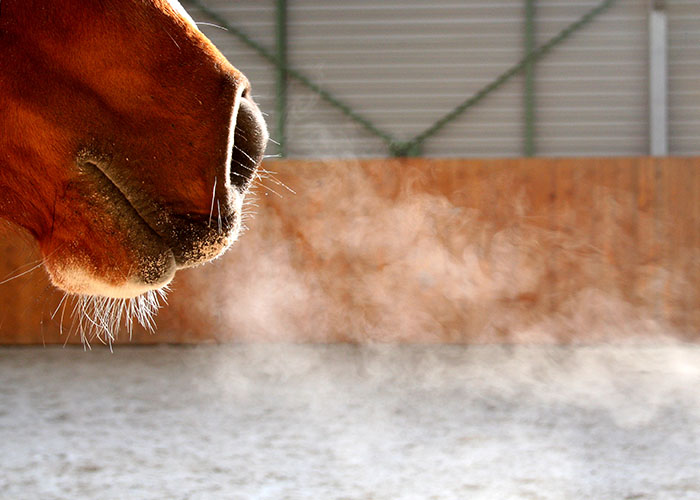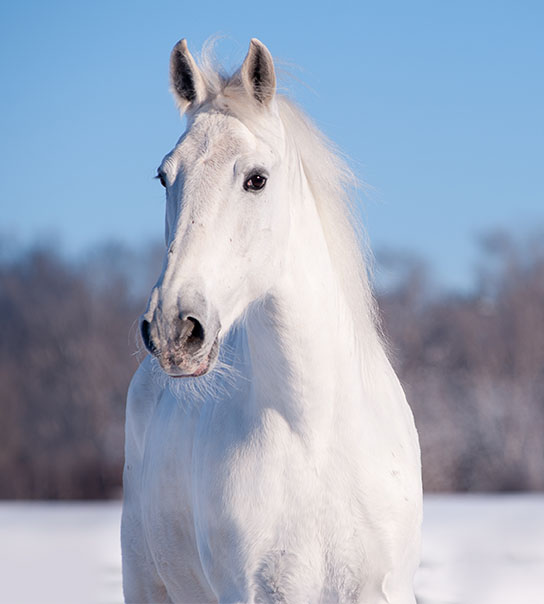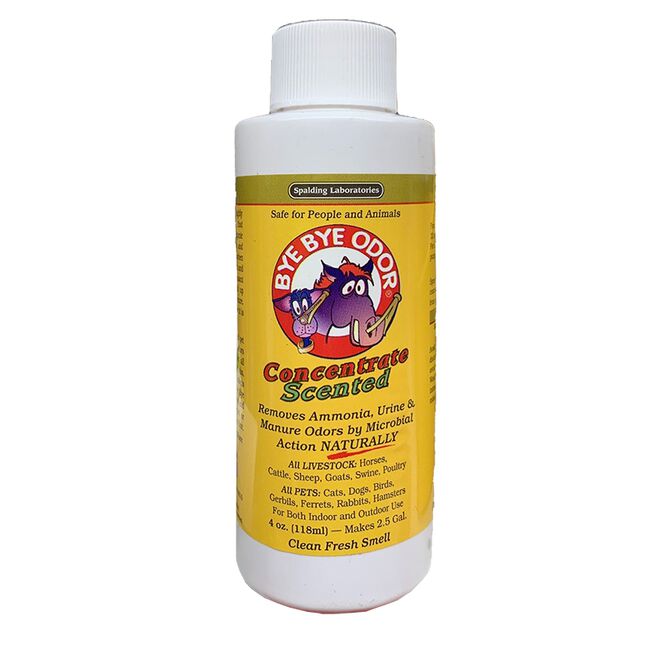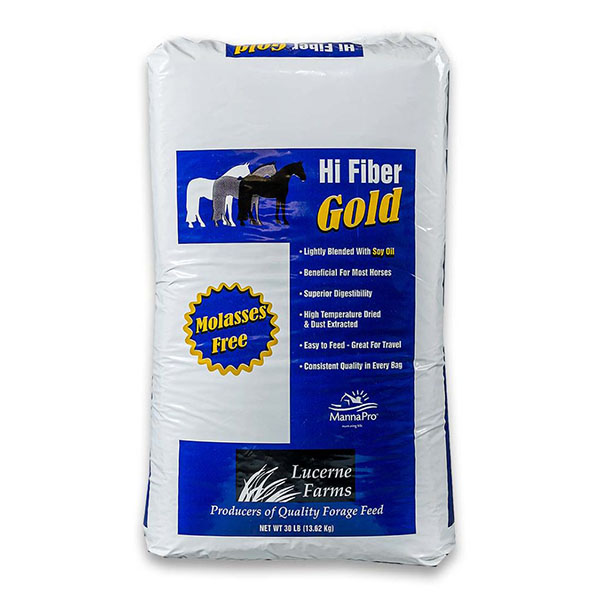
Does your horse have a raspy cough or labored breathing? Does he wheeze when you work him under saddle? Does he often have mucus-filled nostrils? These are all signs that your horse may have heaves.
Heaves is a non-infectious, allergic response to mold in the air, pollen, or dust most commonly found in hay, straw, and bedding. Many times this means that heaves are made worse in the fall and winter months, when your horse may be spending more time in the barn. Comparable to asthma in humans, most affected horses begin to display signs around eight years old.
Melanie Lombardi, DVM, an intern veterinarian at New England Equine Medical and Surgical Center, explains “Heaves, also known as recurrent airway obstruction (RAO), chronic pulmonary obstructive disease (COPD), and broken wind, is a disease characterized by elevated respiratory rate and effort while at rest, a chronic cough, varying degrees of nasal discharge, and exercise intolerance.”
Exposure to allergens or respiratory irritants initiates inflammation in the horse’s airways that results in more mucus while constricting the airways (which makes it harder to breathe), Dr. Lombardi tells us. This, in turn, results in an elevated respiratory rate and increased breathing efforts. In chronic, severe cases of heaves, horses may develop an enlargement (hypertrophy) of the external abdominal oblique muscles that results in a “heave” line coursing across the abdomen.
A likely or presumptive diagnosis of heaves can be made by taking a thorough history from the owner and performing both a physical and a rebreathing examination. “Characteristic wheezing may be heard when listening to the sounds of the trachea and lungs. Further diagnostics to assess the degree of airway inflammation can be performed by airway endoscopy (scope of the trachea) and performing a trans-tracheal wash (TTW) and/or bronchoalveolar lavage (BAL). Accumulation of mucus in the airway can also be visualized on endoscopy,” Dr. Lombardi says. An endoscopy is performed by sending a camera into your horse’s airway, via the nostril. This gives your veterinarian the opportunity to see what is happening in the horse’s upper respiratory system. “Typically, the fluid that is collected by means of TTW or BAL is submitted for cytological analysis (looking at the cells under a microscope). Once the fluid is assessed at a cellular level, the degree of inflammation within the lower airway can be characterized.” In horses affected by heaves, the mucus secretions often show increased white blood cells.

When it comes to treating heaves, the mainstay is management, supportive care, and prevention. Management through control of the environment is the most important treatment linked to alleviating clinical signs horses, and horses with heaves should spend as much time outdoors as possible. Be sure that you monitor your horse’s pasture, however, to ensure that it is as dust-free as possible. For instance, a horse with heaves should not be put out next to a dusty dirt road with heavy traffic, because this may lead to the horse inhaling more dust.
In an acute heaves crisis, a veterinarian may administer a corticosteroid (often Dexamethasone) to help control active inflammation. The horse then may also require a tapering course of steroids to alleviate inflammation over a course of days to weeks. “Medical therapy with inhaled bronchodilators (i.e. albuterol) or inhaled steroids (i.e. Fluticasone propionate, ciclesonide) may help reduce or resolve clinical signs,” says Dr. Lombardi. “Typically, it is recommended that owners purchase an equine inhaler mask or nebulizer to allow for administration of inhaled medications on a long-term basis.”
Most commonly, the offending allergens are found in bedding and forage. If a horse must be stalled for most or part of the day, using dust-extracted shavings with rubber matting can aid in reducing dust particles. It is essential that the barn have adequate ventilation to encourage airflow. Simple management strategies that can be implemented include wetting or steaming the hay, removing the affected horse from the stall before mucking or bedding, watering dusty indoor arenas before riding, and turning out affected horses on grass pasture. The presence of ammonia can also irritate the respiratory tract, so many equestrians utilize a stall refreshing product, such as Spalding Bye Bye Odor Concentrate, to neutralize the noxious gasses.
Spalding Bye Bye Odor Concentrate
This concentrate removes ammonia, urine and manure odors by using microbial action.
Round bales should not be fed to heaves-affected horses, and it is important to clean up hay scraps from stalls and pastures. Both round bales and hay scraps often harbor high levels of respiratory particles. “If your horse has heaves, you may want to consider purchasing a hay steamer, as steaming hay has been shown to eliminate many of the microscopic molds and fungi that are thought to cause heaves,” comments Dr. Lombardi. Other dust-free or low dust forage sources include bagged forage and alfalfa pellets (read more on our blog post, Discover the Benefits of Chopped Forage). If possible, hay should be stored in a separate building (not overhead). It is imperative that horses who are affected with heaves should never eat cow hay, sub-quality hay, or dusty hay, as this may cause lasting damage. Be sure to inspect the hay prior to feeding it to your horse, because even quality hay can become dusty or moldy in storage.
Lucerne Hi-Fiber Gold Dengie
This popular chopped forage product is coated with low levels of soybean oil in order to make it virtually dust-free.
Wetting the hay or soaking the hay is an important part of the management process. There are a number of ways that this can be accomplished. Some horse owners put hay in a hay bag before putting it into a large tote and filling it with water; this approach allows you to grab the hay bag out of the water easily and allow it to drain. Other horse owners drill holes into muck bucket, fill the bucket with hay, and then thoroughly spray down the hay with water. Then the hay can be eaten directly from the bucket or dumped out onto the stall floor. Generally speaking, horses with heaves should be fed at ground level, because this allows the nasal passages to drain as the horse eats.
Hot and humid weather may also make it more difficult for your horse to breathe, so you may need to tailor your riding and exercise routines accordingly. Many times equestrians are able to ride in the early morning and evening hours to help manage their horses with respiratory concerns.
Heaves is usually treatable with proper management and medication regimens, though it is not typically curable. Once diagnosed, horses typically require a lifetime of proper management. It is important to contact your veterinarian to devise the best plan for you and your horse. Once well controlled, most horses with heaves are able to return to a full workload under saddle.



Thanks for the information, a great blog with lots of management tips!